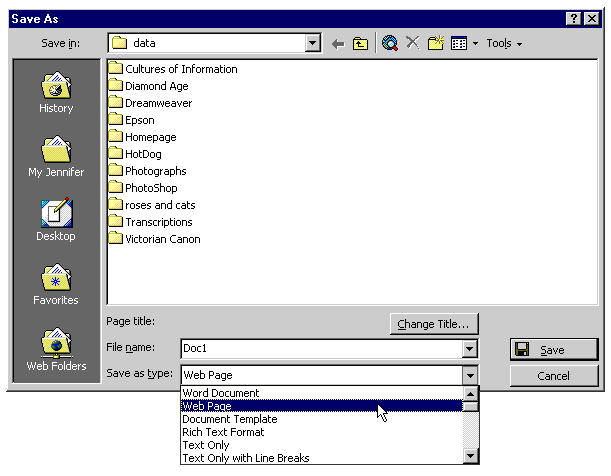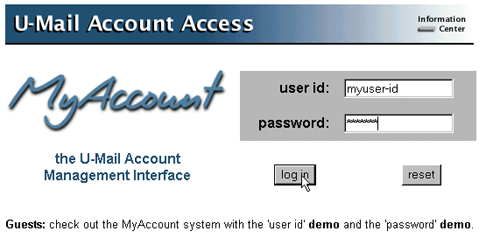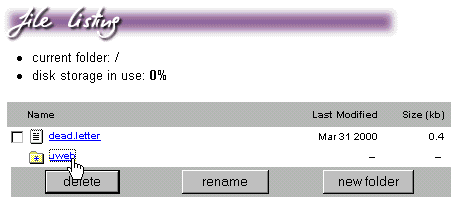Uweb Publishing Basics
For UCSB Students with Umail Email
Accounts
| This tutorial advises you to begin with Microsoft Word
(rather than with Dreamweaver, which is a software application
specifically designed for web writing and publishing)
simply because we have designed the tutorial to be accessible
to you at home with minimal software resources (Microsoft
Word (a popular word-processing application), a web browser
(Internet Explorer (advised) or Netscape Navigator), and
a working internet connection. When you become interested
in editing and/or creating web pages that are increasingly
complex, then you will be best served by learning the
Dreamweaver application. To do this, please see our Getting
Started with Dreamweaver page. If you do not own the
Dreamweaver software, you can access it either in the
Transcriptions Studio (if you are working on a project
for an English course) or in various computer labs all
over campus. |
Step 1: Make Your Page (or Pages)
The Internet is made up of "pages." A page is simply
a document (like a Word document) that is in a specific format
(HTML, ASP) that Internet browsers are designed to display.
To make your own pages, you need to create a document in HTML
format.
The easiest way to do this is to create your document in
Microsoft Word (version 6.0 or higher) and save it as an HTML
document.
1. Create an initial document in Microsoft Word.
Hint: don't spend too much time formatting this document,
because the document will inevitably look different as an
HTML page viewed through an Internet browser. Initially,
just get the content up there using the most basic formatting
techniques (headings, paragraphs, bullets, and the like).
2. Next, save the document. go to the File
menu and select Save as.
The Save as dialog box is displayed.
3. From the Save as type pull-down list, select the
"HTML Document" option. (Note: In some versions
of Microsoft Word, the correct option given for this step
is "Web Page" rather than "HTML Document."
See illustration below:

4. Give the document a name, navigate to the drive onto which
you wish to save this document (very likely this will be the
D:\ drive, which designates that the information be saved
to your Zip Disk), and click Save.
We recommend that you name the document "default.html"
(you'll see why later). Whatever you name it, don't use
spaces or special characters. If you get a message about
formatting being lost, just click OK. You can clean
up formatting later.
5. Close your HTML document when you are ready to upload
it.
Of course, if you have access to a program specifically designed
for making HTML pages (like Dreamweaver
or Frontpage), you will have much more control over formatting.
Step 2: Upload Your Page to the Umail Server
Every UCSB student has web space and an http address
reserved for them to use for their own web publishing. To
"publish" on it, all you need to do is upload your
HTML document to the correct folder on the Umail server. To
do this:
1. Open a browser and go to: http://www.umail.ucsb.edu/
2. Click on the "My Account" icon:

3. Enter your user id and password
(same as for your Umail email account):

4. Click on Storage Manager in the navigation
bar.
5. Open (click on) the "Uweb" folder
in the "File Listings" area.

6. Go to the "File Upload" area and
click on the Browse button.
This allows you to select a file you want to upload (i.e.,
the HTML document you just created)
7. Find your HTML document, select it, and click Open.

8. Click the Upload File button.
the "File Listings" area will be redisplayed
showing the file you just uploaded.
Step 3: Test It
1. (Optional) Leaving the Storage Manager window up, open
a new browser window.
This is so that you don't have to keep logging on to your
Umail account for subsequent uploads.
2. If you named your HTML document "default.html,"
go to:
http://www.uweb.ucsb.edu/~[your user id]/
** If you named your HTML document something else, go to:
http://www.uweb.ucsb.edu/~[your user id]/[file name]
Now the document will appear in the browser window.
Step 4: Edit the Document
If you want to make changes to the document, you can edit
it and re-upload it until it looks the way you want it to
look. Formatting HTML pages always involves a great deal of
experimentation: you just have to experiment with the available
formatting options in the editing program you are using (Microsoft
Word, Dreamweaver, Frontpage, etc.) and repeatedly save and
re-open the document in a browser to see how it really looks.
Note: If you are interested in learning Dreamweaver, which
is a software application specifically designed for web
writing and publishing, please see our Getting
Started with Dreamweaver page. You will find that you
have much more control over your HTML documents in Dreamweaver
than you do in Microsoft Word. If you become interested
in creating your own graphics from documents not already
in a digital format, check out our Scanning
Basics tutorial as well.
|